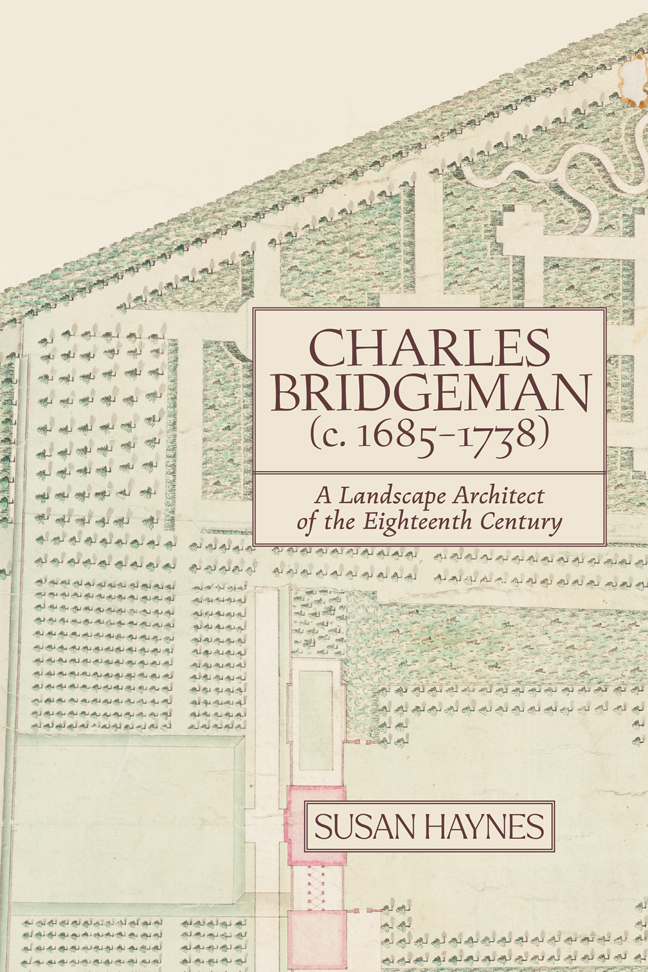Book contents
- Frontmatter
- Dedication
- Maps
- Contents
- List of Illustrations
- Acknowledgements
- List of Abbreviations
- Introduction
- Chapter 1 Who Was Charles Bridgeman?
- Chapter 2 Towards A Reliable Corpus
- Chapter 3 A Revised Catalogue
- Chapter 4 Reading The Plans
- Chapter 5 The Art-Historical Context Revisited
- Chapter 6 The ‘Ingenious Mr Bridgeman’
- Chapter 7 Building a Landscape
- Chapter 8 A Commercial Enterprise
- Conclusion
- Appendix I A summary of Willis's catalogue from Charles Bridgeman and the English Landscape Garden
- Appendix II A revised catalogue
- Appendix III Bridgeman's projects by year
- Appendix IV Bridgeman's income
- Gazetteer of Bridgeman sites
- Glossary
- Bibliography
- Index
- Miscellaneous Endmatter
Chapter 5 - The Art-Historical Context Revisited
Published online by Cambridge University Press: 21 February 2024
- Frontmatter
- Dedication
- Maps
- Contents
- List of Illustrations
- Acknowledgements
- List of Abbreviations
- Introduction
- Chapter 1 Who Was Charles Bridgeman?
- Chapter 2 Towards A Reliable Corpus
- Chapter 3 A Revised Catalogue
- Chapter 4 Reading The Plans
- Chapter 5 The Art-Historical Context Revisited
- Chapter 6 The ‘Ingenious Mr Bridgeman’
- Chapter 7 Building a Landscape
- Chapter 8 A Commercial Enterprise
- Conclusion
- Appendix I A summary of Willis's catalogue from Charles Bridgeman and the English Landscape Garden
- Appendix II A revised catalogue
- Appendix III Bridgeman's projects by year
- Appendix IV Bridgeman's income
- Gazetteer of Bridgeman sites
- Glossary
- Bibliography
- Index
- Miscellaneous Endmatter
Summary
AS WITH MOST artists and designers, an effort has been made by subsequent academic writing to fit Bridgeman into the cultural and artistic context of his period. In the early eighteenth century, the period in which he was working, the elite – the rich, the intelligentsia, the literati – were preoccupied with defining themselves in the light of several essentially separate but closely related ideas. They discoursed in print, in correspondence and in conversation on the relationship between nature and the garden, the culture and politics of ancient Rome, the art, architecture and landscapes of Europe, and the development of a sense of Englishness which was distinct from the Europeaness of the near continent. So pervasive and persuasive did this discourse become that it has stood for the cultural life of the early eighteenth century ever since. Bridgeman was certainly more than peripherally involved in the elite and artistic circles where these topics were the badge of belonging, so perhaps it is no wonder that he was considered part of it. What is less clear is how it affected his work.
Bridgeman was both personally and professionally connected with those fashionable artistic circles. In 1726 he was elected a member of the Society of the Virtuosi of St Luke (c.1689–1743), ‘the Tip top Clubbs of all, for men of the highest Character in Arts & Gentlemen Lovers of Art’ (see Chapter 1), presumably following his appointment as Royal Gardener (Vertue, Note books, 3.120). His fellow members included architect James Gibbs and writer George Vertue, the painter John Wootton, the enamellist Christian Friedrick Zincke and the sculptor John Michael Rysbrack, all of whom were elected in the same year as Bridgeman. Sir James Thornhill was also a member. His importance in these artistic circles is also implicit in his appearance in the painting A Club of Artists (1735), attributed to Gawen Hamilton, in which he appears with, amongst others, George Vertue, Michael Dahl, James Gibbs, John Wootton and William Kent, and in his appearance in Hogarth's The Rake's Progress. He was on visiting terms with the poet Alexander Pope.
Through the Office of Works, these connections were reinforced. The Office of Works was in charge of building for the monarchy from the medieval period. By the early eighteenth century this effectively meant all work on the royal palaces, buildings and land.
- Type
- Chapter
- Information
- Charles Bridgeman (c. 1685-1738)A Landscape Architect of the Eighteenth Century, pp. 79 - 94Publisher: Boydell & BrewerPrint publication year: 2023



